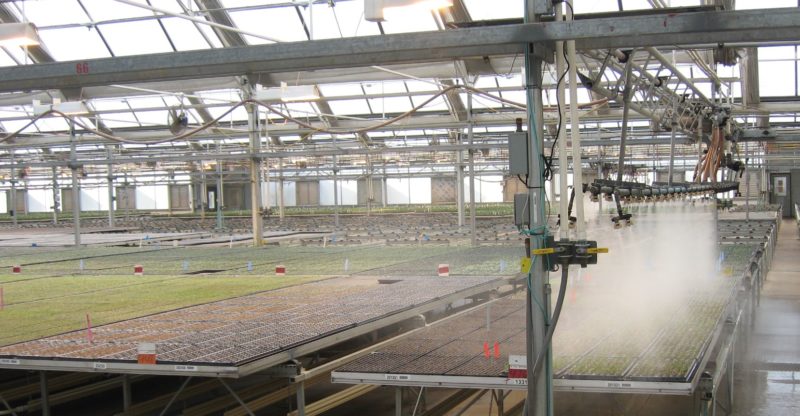
Propagation Pointers
Propagating ornamental crops is one of the most challenging aspects of production, yet an increasing number of greenhouse growers are doing it themselves.
The success of a finished crop is highly dependent on the success of propagation; if you start with well-rooted, uniform, and vigorous (but not overgrown) plugs or liners, crops are much more likely to finish in a predictable and uniform manner, be of high quality, and have fewer production challenges.
This article provides a brief overview of tips for successful propagation.
Minimize storage of cuttings. Once boxes of unrooted cuttings arrive, open and inspect them immediately. While most cuttings can be stored in their bags in darkness for one or two days at 50° F, do your best to stick them as soon as possible. This is especially important for geranium, sweet potato vine, lantana, heliotrope and thunbergia.
Use a porous propagation medium. Too often, growers propagate in a heavy mix that retains a lot of water. Rooting of cuttings is inhibited when a substrate lacks sufficient oxygen, so for most crops (especially those with fleshy or hairy stems), use one that contains an elevated percentage of perlite or other component that retains little water. This is especially important for Northern growers during the winter, when water loss is slow.
Control the VPD. The vapor-pressure deficit (VPD) quantifies the amount of moisture in the air compared with its holding capacity. When air is saturated with water vapor, its VPD is zero, so there is extremely little loss of water from the plant or its substrate to the air around it. Water loss increases as the VPD increases. During the early phase(s) of propagation, a VPD of 0.3 or 0.4 kPa is recommended (85 to 90% relatively humidity at 73° F) so that water loss occurs but is relatively slow. As seedlings or cuttings develop roots, increase the VPD (i.e., reduce humidification) to promote root development and uptake of nutrients.
Progressively mist. For cuttings, misting should be delivered just enough so that leaves do not wilt. Misting of germinating seed is more variable; some species germinate better at a high moisture content while others perform better with a little dry down. Regardless, misting frequency should depend on the humidity and light levels, and progressively decrease as plants develop a root system. When the VPD is managed, misting frequency can be reduced, which also reduces leaching of nutrients and growth of algae. Regularly provide sufficient but not excessive fertilizer, such as 50- to 75-ppm nitrogen, that includes micronutrients.
Control root-zone temperature. Assuming light is not a limitation, root development increases with temperature, until some crop-specific temperature. In most situations, bottom heating is necessary to reach a recommended root-zone temperature of 72 to 75° F. Without bottom heating, the root zone is usually cooler than the air temperature, sometimes significantly so. This is partly because the temperature of water is usually much cooler than the air. A warmer root than shoot temperature will favor root growth more than shoot growth.
Temper light. Adequate but not excessive light is essential for rapid rooting of seedlings and cuttings. During the darkest months of the year, supplemental lighting to obtain an average daily light integral of 5 to 8 mol·m–2·d–1 will greatly accelerate rooting compared to a lower or higher one. The instantaneous light intensity should also be controlled the first several days of cutting propagation so that it does not exceed around 200 μmol·m–2·s–1. Ideally, the sunlight should be diffuse and not direct. Once the roots of young plants reach the edge of the cell,
more light will further advance rooting as well as growth and branching of shoots.
Proactively limit pests. Following strict sanitation protocols, proper environmental management, and not over-watering will greatly reduce problems with insects, diseases, viruses and algae. Growers with the cleanest propagation greenhouses and concrete floors often have the fewest pest problems.
Use PGRs carefully. Extension growth can be suppressed by good management of the environment and limiting fertility, but plant growth retardants (PGRs) are still often needed, especially towards the later phases of propagation. Sprays are
usually preferred because late drenches can inhibit rooting after transplant. Apply sprays strategically so that mist does not wash off the PGR, and considering adding a surfactant when low rates of PGRs are used to ensure good plant contact.
Invest in your propagation facility. Considering the high value of young-plant production, investing in a sophisticated greenhouse is often worthwhile. Concrete floors, bottom heating, supplemental lighting, retractable curtains and an environmentbased automatic misting/fogging system can reduce propagation times, limit pest problems and reduce shrinkage (Figure 1).


 Video Library
Video Library 




















